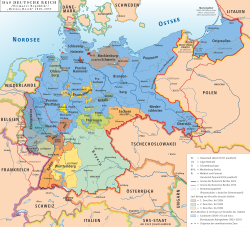ສາທາລະນະລັດໄວມາ
ສາທາລະນະລັດໄວມາ ເຍຍລະມັນ Reich Deutsches Reich (German)
| |||||||||
|---|---|---|---|---|---|---|---|---|---|
| 1918–1933[1][2][3] | |||||||||
ຄຳຂວັນ: Einigkeit und Recht und Freiheit ("ຄວາມສາມັກຄີ ແລະຍຸຕິທຳ ແລະເສລີພາບ") | |||||||||
| ເມືອງຫຼວງ | ເບີລິນ 52°31′N 13°23′E / 52.517°N 13.383°E | ||||||||
| ເມືອງໃຫຍ່ທີ່ສຸດ | ນະຄອນຫຼວງ | ||||||||
| ພາສາລັດຖະການ | ເຢຍລະມັນ | ||||||||
| ພາສາທົ່ວໄປ | ບໍ່ເປັນທາງການ:
Low German, Polish, Limburgish, Frisian, Yiddish, Danish, Sorbian, Sinte Romani, Lithuanian | ||||||||
| ສາສະໜາ | 1925 census:[5]
| ||||||||
| ເດມະນິມ | ເຢຍລະມັນ | ||||||||
| ການປົກຄອງ | Federal representative semi-presidential republic | ||||||||
| ປະທານາທິບໍດີ | |||||||||
• 1919–1925 | Friedrich Ebert | ||||||||
• 1925–1933 | Paul von Hindenburg | ||||||||
| Chancellor | |||||||||
• 1919 (ຄັ້ງທໍາອິດ) | Friedrich Ebert | ||||||||
• 1933 (ສຸດທ້າຍ) | Adolf Hitler | ||||||||
| ສະພານິຕິບັນຍັດ | Bicameral | ||||||||
• Upper house | Reichsrat (de facto) | ||||||||
• Lower house | Reichstag | ||||||||
| ຍຸກປະຫວັດສາດ | Interwar period | ||||||||
• ກໍ່ຕັ້ງ | 9 ພະຈິກ 1918 | ||||||||
• ລັດຖະທຳມະນູນ | ວັນທີ 11 ສິງຫາ 1919 | ||||||||
• ຍອມຮັບເຂົ້າ ສະຫະພັນປະຊາຊາດ | ວັນທີ 8 ກັນຍາ 1926 | ||||||||
• ການປົກຄອງໂດຍລັດຖະດຳລັດ ເລີ່ມຕົ້ນ | ວັນທີ 29 ມີນາ 1930[6] | ||||||||
• Hitler inaugurated Chancellor | ວັນທີ 30 ມັງກອນ 1933 | ||||||||
• Reichstag fire | 27 ກຸມພາ 1933 | ||||||||
• Enabling Act | 23 ມີນາ 1933[1][2][3] | ||||||||
| ພື້ນທີ່ | |||||||||
| 1925[7] | 468,787 ຕາລາງກິໂລແມັດ (181,000 ຕາລາງໄມລ໌) | ||||||||
| ປະຊາກອນ | |||||||||
• 1925[7] | 62,411,000 | ||||||||
• ຄວາມໜາແໜ້ນ | 133.129 ຕໍ່ຕາລາງກິໂລແມັດ (344.8 ຕໍ່ຕາລາງໄມລ໌) | ||||||||
| ສະກຸນເງິນ |
| ||||||||
| |||||||||
| ປັດຈຸບັນເປັນສ່ວນໜຶ່ງຂອງ |
| ||||||||
ສາທາລະນະລັດໄວມາ, ເປັນທີ່ຮູ້ຈັກຢ່າງເປັນທາງການເປັນ ເຍຍລະມັນ Reich, ເປັນໄລຍະປະຫວັດສາດຂອງເຢຍລະມັນຈາກ 9 ເດືອນພະຈິກ 1918 ຫາ 23 ເດືອນມີນາ 1933, ໃນໄລຍະທີ່ມັນເປັນ ລັດຖະບານກາງ ລັດຖະທໍາມະນູນ ເປັນຄັ້ງທໍາອິດໃນປະຫວັດສາດ; ເພາະສະນັ້ນມັນຍັງຖືກເອີ້ນວ່າ, ແລະປະກາດຢ່າງບໍ່ເປັນທາງການ, ເປັນ ສາທາລະນະລັດເຢຍລະມັນ. ຊື່ບໍ່ເປັນທາງການຂອງໄລຍະເວລາແມ່ນມາຈາກເມືອງ ໄວມາ, ເຊິ່ງເປັນເຈົ້າພາບຂອງ ສະພາຜູ້ປະກອບການ ສ້າງຕັ້ງລັດຖະບານຂອງຕົນ. ໃນພາສາອັງກິດ, ສາທາລະນະລັດມັກຈະເອີ້ນວ່າ "ເຢຍລະມັນ", ໂດຍ "ສາທາລະນະລັດໄວມາ" (ຄໍາທີ່ແນະນໍາໂດຍ ອາໂດນ ຮິດແລ ໃນປີ 1929) ບໍ່ໄດ້ຖືກນໍາໃຊ້ທົ່ວໄປຈົນກ່ວາ 1930s. ສາທາລະນະລັດ ໄວມາ ມີ ລະບົບເຄິ່ງປະທານາທິບໍດີ.
ເອກະສານອ້າງອີງ
- ↑ Hosch, William L. (23 March 2007). "The Reichstag Fire and the Enabling Act of March 23, 1933". Britannica Blog (in ອັງກິດ (ອາເມລິກັນ)). Archived from the original on 11 March 2019. Retrieved 30 March 2017.
- ↑ "The law that 'enabled' Hitler's dictatorship". DW.com (in ອັງກິດ). 23 March 2013. Archived from the original on 7 September 2019. Retrieved 30 March 2017.
- ↑ Mason, K. J. Republic to Reich: A History of Germany 1918–1945. McGraw-Hill.
- ↑ Winfried Klein. "Wer sind wir, und was wollen wir dazu singen?", Frankfurter Allgemeine Zeitung, 2012-09-14
- ↑ Volume 6. Weimar Germany, 1918/19–1933 Population by Religious Denomination (1910–1939) Archived 9 ສິງຫາ 2016 at the Wayback Machine Sozialgeschichtliches Arbeitsbuch, Volume III, Materialien zur Statistik des Deutschen Reiches 1914–1945, edited by Dietmar Petzina, Werner Abelshauser and Anselm Faust. Munich: Verlag C. H. Beck, 1978, p. 31. Translation: Fred Reuss.
- ↑ Cite warning:
<ref>tag with name:0cannot be previewed because it is defined outside the current section or not defined at all. - ↑ 7.0 7.1 "Das Deutsche Reich im Überblick". Wahlen in der Weimarer Republik. Archived from the original on 21 November 2019. Retrieved 26 April 2007.



